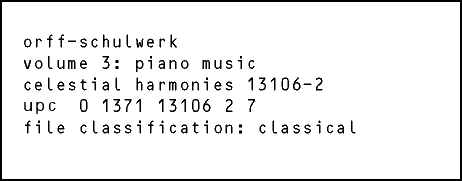 |
|||||||||||||||||||||||||||||||||||||||||||||||||||||||||||||||||||||||||||||||||||||||||||||||||||||||||||||||||||||||||||||||||||||||||||||||||||||||||
 
Weltberühmt wurde er durch seine „Carmina Burana“, eines der meistgespielten Werke klassischer Musik überhaupt. Noch wirksamer war jedoch eine Fülle von kleinen Kompositionen zu pädagogischen Zwecken. Fast jede deutsche Schule hat seit einem halben Jahrhundert ein „Orff-Instrumentarium“. Schlaginstrumente wie Xylophone, Tamburin und Triangel repräsentieren dabei einen für die europäische Klassik ungewöhnlichen, für Orff jedoch typischen Ansatz: die körperorientierte Rhythmik („Am Anfang war die Trommel“). Kinder (wie auch Patienten der Musiktherapie) lernen Rhythmusgefühl als musikalische Basis, Koordination aller körperlich-geistigen Bewegungen, erfahren Erdung. Doch das hier vorgestellte (zum großen Teil in Zusammenarbeit mit Gunhild Keetman entstandene) Orff-Schulwerk umfasst das ganze Spektrum der Musik. Es ist Orffs Lebenswerk und wahres Vermächtnis: Anregung für jeden, selbst zu musizieren oder zumindest aktiv zu hören. Die erste digitale Aufnahme zu Orffs 100. Geburtstag mit Künstlern, die noch bei Orff selbst studierten. Die insgesamt 38, von Nikolaus Lahusen und Wilfried
Hiller gespielten Klavierstücke repräsentieren im steigenden
Schwierigkeitsgrad die Ausbildung im Pflichtfach Klavier an der Münchner
Günther Schule (für moderne Körper- und Tanzerziehung).
Schon die ersten einfachen melodischen Stücke haben etwas enorm
Durchgeistigtes, die rhythmisch schwierigeren erinnern z.T. an Bartoks
Klavierstücke. Andere sind Improvisationsanleitungen zum Bordun-
oder Ostinatobass. Einige dieser Miniaturen waren Vorlagen für
Orffs große Bühnenwerke. Nicht nur für Klavierlehrer
ein Muss!
the projectOrff-Schulwerk Volume 3: Piano Music combines the musical styles of both Carl Orff and his wife Gertrud Orff. It is also the world premiere recording of Carl Orff's Bordunübungen (drone exercises), representing a different approach to piano playing—based on pure piano improvisation. Orff's Bordunübungen was developed for work with the advanced pupils at the Günther-Schule. "Growing out of improvisation, these pieces always lead back to improvisation," writes Orff in his Dokumentation, "finding out, invention and discovery were what mattered. The players should grow ears on their fingers." Gunild Keetman captures these lessons in her Erinnerungen (Memories) as follows: "When Orff sat down at the piano and began to play—I don't recall what he played, but rather how: that is to say with four or more hands—he magically created new sounds...Or he improvised new and surprising material and could hardly stop playing..." The choice of works on this recording give at least a hint of the stylistic variety which short piano pieces can exhibit. Gertrud Orff's Kleine Klavierstücke of 1954 are indeed also succinct condensed versions of material and expression, yet they are of a completely different nature than Carl Orff's works. Gertrud's twenty-four miniatures are more refined and discordant in character than the Klavierübungen, with their driving inner power, composed by her husband, Carl Orff. Her sensitive works often are reminiscent of Japanese watercolor paintings, they were ably developed on the spur of the moment. They "came to be and took form as finished structures", as Gertrud Orff herself writes. They were invented at the keyboard as felt forms, as works that were created from the hand, for the hand. Some of these pieces seem, in their clearness, like the beginning of a story to be told, like an opening such as, "Once upon a time..." or "it happened in earlier times that..." a true ending is often lacking, several pieces end in harmonic openness. the artistsArtistic executor of the Carl Orff estate, Wilfried Hiller, faithfully and conscientiously follows the models of Orff's musical styles in this third volume of the three volume series of Orff-Schulwerk recordings. He is the artistic director and co-producer of this recording and lends his Orff teachings in support of pianist Nikolaus Lahusen on several pieces—adjoining additional repetitions of the simpler beginning examples at the ends of pieces, playing lines in a different octave and doubling musical lines at the octave. Nikolaus Lahusen was born in Bremen in 1960 and grew up in Mexico. His artistic development was supported by Edith Picht-Axenfeld, Christoph Eschenbach and Bruno Leonardo Gelber. Nikolaus Lahusen has been counted among the leading pianists of his generation for several years. He has given concerts and performed with leading orchestras worldwide. Lahusen's performance at the Orff-Nacht, organized in honor of Orff's 100th birthday in Munich, summer of 1995, was revered by the press as outstanding and led to the recording of this release. biographydiscographytracklist (deutsche beiheft-texte)
|
|||||||||||||||||||||||||||||||||||||||||||||||||||||||||||||||||||||||||||||||||||||||||||||||||||||||||||||||||||||||||||||||||||||||||||||||||||||||||
|
|
|||||||||||||||||||||||||||||||||||||||||||||||||||||||||||||||||||||||||||||||||||||||||||||||||||||||||||||||||||||||||||||||||||||||||||||||||||||||||
 |


